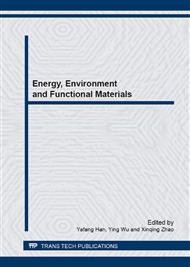[1]
Y. Yu, R. Wu, M. Clark, Phosphate removal by hydrothermally modified fumed silica and pulverized oyster shell.J. Colloid Interf. Sci. 350 (2010) 538-543.
DOI: 10.1016/j.jcis.2010.06.033
Google Scholar
[2]
S.G. Lu, S.Q. Bai, L. Zhu, H.D. Shan, Removal mechanism of phosphate from aqueous solution by fly ash, J.Hazard.Mater. 161 (2009) 95-101.
DOI: 10.1016/j.jhazmat.2008.02.123
Google Scholar
[3]
A. Ugurlu, B. Salman, Phosphate removal from water by fly ash, Environ. Int. 24 (1998) 911–918.
Google Scholar
[4]
Y. Xue, H. Hou, S. Zhu, Characteristics and mechanisms of phosphate adsorption onto basic oxygen furnace slag, J.Hazard.Mater. 162 (2009) 973-980.
DOI: 10.1016/j.jhazmat.2008.05.131
Google Scholar
[5]
Shinsuke Nagamine,Takuro Ueda,Iwao Masuda,Taiji Mori,Eiji Sasaoka,Isao Joko,Ind.Eng.Chem.Res.42 (2003) 4748–4752.
DOI: 10.1021/ie030189y
Google Scholar
[6]
S. S.Lin,D. A.Carlson, Phosphorus Removal by the Addition of Aluminum (III) to the Activated Sludge Process, J.WaterPollut.Control Fed. 47(1975) 1978-1986.
Google Scholar
[7]
Jyotsnamayee Pradhan, Jasobanta Das, Surendranath Das, R.S. Thakur, Adsorption ofPhosphatefromAqueousSolutionUsingActivatedRedMud,J.ColloidInterf. Sci. 204 (1998) 169-172.
Google Scholar
[8]
E. Galarneau, R. Gehr, Phosphorus removal from wastewaters: Experimental and theoretical support for alternative mechanisms, Water Res. 31 (1997) 328-338.
DOI: 10.1016/s0043-1354(96)00256-4
Google Scholar
[9]
K.Urano, H.Tachikawa, Ind. Eng. Chem. Res. 31(1992)1510–1513.
Google Scholar
[10]
K.Urano,H.Tachikawa, M.Kitajima,Process development for removal and recovery of phosphorus from wastewater by a new adsorbent. 4. Recovery of phosphate and aluminum from desorbing solution, Ind. Eng. Chem. Res.31 (1992), 1513–1515.
DOI: 10.1021/ie00006a013
Google Scholar
[11]
J.P. Gustafsson, A. Renman, G. Renman, K. Poll, Phosphate removal by mineral-based sorbents used in filters for small-scale wastewater treatment, Water Res. 42 (2008) 189-197.
DOI: 10.1016/j.watres.2007.06.058
Google Scholar
[12]
W.H. Park, C. Polprasert, Roles of oyster shells in an integrated constructed wetland system designed for P removal,Ecol.Eng. 34 (2008) 50-56.
DOI: 10.1016/j.ecoleng.2008.05.014
Google Scholar
[13]
H.-B. Kwon, C.-W. Lee, B.-S. Jun, J.-d. Yun, S.-Y. Weon, B. Koopman, Recycling waste oyster shells for eutrophication control, Resour. Conserv.Recycl. 41 (2004) 75-82.
DOI: 10.1016/j.resconrec.2003.08.005
Google Scholar
[14]
B. Pan, B. Pan, X. Chen, W. Zhang, X. Zhang, Q. Zhang, Q. Zhang, J. Chen, WaterRes. 40 (2006) 2938-2946.
Google Scholar
[15]
C. Namasivayam, A. Sakoda, M. Suzuki, Removal of phosphate by adsorption onto oyster shell powder?kinetic studies. J. Chem. Technol. Biotechnol. 80 (2005) 356-358.
DOI: 10.1002/jctb.1175
Google Scholar
[16]
A.S. Özcan, Ö. Gök, A. Özcan, Adsorption of lead(II) ions onto 8-hydroxy quinoline-immobilized bentonite, J.Hazard.Mater. 161 (2009) 499-509.
DOI: 10.1016/j.jhazmat.2008.04.002
Google Scholar
[17]
W. Liang, L. Zhan, L. Piao, C. Rüssel, Lead and copper removal from aqueous solutions by porous glass derived calcium hydroxyapatite, Mater. Sci. Eng.: B. 176 (2011) 1010-1014.
DOI: 10.1016/j.mseb.2011.05.036
Google Scholar
[18]
Y.H. Huang, C.L. Hsueh, C.P. Huang, L.C. Su, C.Y. Chen, Adsorption thermodynamic and kinetic studies of Pb(II) removal from water onto a versatile Al2O3-supported iron oxide, Sep. Purif. Technol. 55 (2007) 23-29.
DOI: 10.1016/j.seppur.2006.10.023
Google Scholar


